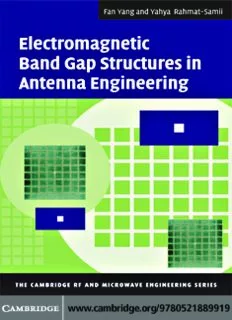
Electromagnetic Band Gap Structures in Antenna Engineering PDF
Preview Electromagnetic Band Gap Structures in Antenna Engineering
This page intentionally left blank ElectromagneticBandGapStructuresinAntennaEngineering Thiscomprehensive,applications-orientedsurveyofthestateoftheartinElectromag- netic Band Gap (EBG) engineering explains the theory, analysis, and design of EBG structures.IthelpsyoutounderstandEBGapplicationsinantennaengineeringthrough anabundanceofnovelantennaconcepts,awealthofpracticalexamples,andcomplete designdetails.Youdiscoveracustomizedfinitedifferencetimedomain(FDTD)method ofEBGanalysis,forwhichaccurateandefficientelectromagneticsoftwareissupplied (www.cambridge.org/yang)toprovideapowerfulcomputationalengineforyourEBG desgins.ThefirstbookcoveringEBGstructuresandtheirantennaapplications,thispro- videsadynamicresourceforengineers,andresearchersandgraduatestudentsworking inantennas,electromagneticsandmicrowaves. FanYangisAssistantProfessoroftheElectricalEngineeringDepartmentattheUniversity ofMississippi.Dr.YangreceivedYoungScientistAwardsinthe2005GeneralAssembly ofInternationalUnionofRadioScience(URSI)andinthe2007InternationalSymposium onElectromagneticTheory. Yahya Rahmat-Samii is a Distinguished Professor, holder of the Northrop-Grumman ChairinElectromagnetics,andpastChairmanoftheElectricalEngineeringDepartment attheUniversityofCalifornia,LosAngeles(UCLA).Hehasreceivednumerousrecog- nitionsandawardsincludingIEEEFellowin1985,IEEEThirdMillenniumMedal,the 2005URSIBookerGoldMedal,the2007Chen-ToTaiDistinguishedEducatorAward of the IEEE Antennas and Propagation Society, and membership of the US National AcademyofEngineering. TheCambridgeRFandMicrowaveEngineeringSeries SeriesEditor, SteveC.Cripps,HywaveAssociates PeterAaen,JaimeA.Pla´,andJohnWood,ModelingandCharacterizationofRFand MicrowavePowerFETs EnricoRubiola,PhaseNoiseandFrequencyStabilityinOscillators DominiqueSchreurs,Ma´irt´ınO’Droma,AnthonyA.Goacher,andMichaelGadringer, RFAmplifierBehavioralModeling FanYangandYahyaRahmat-Samii,ElectromagneticBandGapStructuresinAntenna Engineering Forthcoming SorinVoinigescuandTimothyDickson,High-FrequencyIntegratedCircuits DebabaniChoudhury,MillimeterWavesforCommercialApplications J.StephensonKenney,RFPowerAmplifierDesignandLinearization DavidB.Leeson,MicrowaveSystemsandEngineering StepanLucyszyn,AdvancedRFMEMS EarlMcCune,PracticalDigitalWirelessCommunicationsSignals AllenPodellandSudiptoChakraborty,PracticalRadioDesignTechniques PatrickRoblin,NonlinearRFCircuitsandtheLarge-SignalNetworkAnalyzer DominiqueSchreurs,MicrowaveTechniquesforMicroelectronics JohnL.B.Walker,HandbookofRFandMicrowaveSolid-StatePowerAmplifiers Electromagnetic Band Gap Structures in Antenna Engineering FAN YANG UniversityofMississippi YAHYA RAHMAT-SAMII UniversityofCaliforniaatLosAngeles CAMBRIDGE UNIVERSITY PRESS Cambridge, New York, Melbourne, Madrid, Cape Town, Singapore, São Paulo Cambridge University Press The Edinburgh Building, Cambridge CB2 8RU, UK Published in the United States of America by Cambridge University Press, New York www.cambridge.org Information on this title: www.cambridge.org/9780521889919 ©Cambridge University Press 2009 This publication is in copyright. Subject to statutory exception and to the provision of relevant collective licensing agreements, no reproduction of any part may take place without the written permission of Cambridge University Press. First published in print format 2008 ISBN-13 978-0-511-45579-7 eBook (EBL) ISBN-13 978-0-521-88991-9 hardback Cambridge University Press has no responsibility for the persistence or accuracy of urls for external or third-party internet websites referred to in this publication, and does not guarantee that any content on such websites is, or will remain, accurate or appropriate. Contents Preface page ix Acknowledgements xi Abbreviations xii 1 Introduction 1 1.1 Background 1 1.2 Electromagneticbandgap(EBG)structures 2 1.2.1 EBGdefinition 2 1.2.2 EBGandmetamaterials 4 1.3 AnalysismethodsforEBGstructures 6 1.4 EBGapplicationsinantennaengineering 8 1.4.1 Antennasubstratesforsurfacewavesuppressions 8 1.4.2 Antennasubstratesforefficientlowprofilewireantennadesigns 9 1.4.3 Reflection/transmissionsurfacesforhighgainantennas 10 2 FDTDmethodforperiodicstructureanalysis 14 2.1 FDTDfundamentals 14 2.1.1 Introduction 14 2.1.2 Yee’scellandupdatingscheme 15 2.1.3 Absorbingboundaryconditions:PML 18 2.1.4 FDTDexcitation 22 2.1.5 Extractionofcharacteristicparameters 23 2.2 Periodicboundaryconditions 24 2.2.1 FundamentalchallengesinPBC 24 2.2.2 OverviewofvariousPBCs 25 2.2.3 Constantk methodforscatteringanalysis 26 x 2.3 Guidedwaveanalysis 30 2.3.1 Problemstatement 30 2.3.2 Brillouinzoneforperiodicwaveguides 31 2.3.3 Examples 33 2.4 Planewavescatteringanalysis 37 2.4.1 Problemstatement 38 2.4.2 Planewaveexcitation 39 2.4.3 Examples 41 vi Contents 2.5 Aunifiedapproach:hybridFDTD/ARMAmethod 45 2.5.1 Aunifiedapproachforguidedwaveandscatteringanalysis 45 2.5.2 ARMAestimator 49 2.5.3 Examples 51 2.6 Projects 54 3 EBGcharacterizationsandclassifications 59 3.1 ResonantcircuitmodelsforEBGstructures 59 3.1.1 EffectivemediummodelwithlumpedLCelements 59 3.1.2 Transmissionlinemodelforsurfacewaves 61 3.1.3 Transmissionlinemodelforplanewaves 62 3.2 Graphicrepresentationoffrequencybandgap 63 3.2.1 FDTDmodel 63 3.2.2 Nearfielddistributionsinsideandoutsidethefrequencyband gap 65 3.3 Frequencybandgapforsurfacewavepropagation 67 3.3.1 Dispersiondiagram 67 3.3.2 Surfacewavebandgap 68 3.4 In-phasereflectionforplanewaveincidence 69 3.4.1 Reflectionphase 69 3.4.2 EBGreflectionphase:normalincidence 70 3.4.3 EBGreflectionphase:obliqueincidence 71 3.5 Softandhardsurfaces 74 3.5.1 Impedanceandreflectioncoefficientofaperiodicgroundplane 75 3.5.2 Softandhardoperations 77 3.5.3 Examples 80 3.6 ClassificationsofvariousEBGstructures 84 3.7 Project 85 4 DesignsandoptimizationsofEBGstructures 87 4.1 Parametricstudyofamushroom-likeEBGstructure 87 4.1.1 Patchwidtheffect 87 4.1.2 Gapwidtheffect 89 4.1.3 Substratethicknesseffect 89 4.1.4 Substratepermittivityeffect 90 4.2 Comparisonofmushroomanduni-planarEBGdesigns 91 4.3 Polarization-dependentEBGsurfacedesigns 95 4.3.1 RectangularpatchEBGsurface 95 4.3.2 SlotloadedEBGsurface 97 4.3.3 EBGsurfacewithoffsetvias 97 4.3.4 Anexampleapplication:PDEBGreflector 99 4.4 CompactspiralEBGdesigns 103 4.4.1 Singlespiraldesign 103 Contents vii 4.4.2 Doublespiraldesign 105 4.4.3 Four-armspiraldesign 105 4.5 DuallayerEBGdesigns 107 4.6 Particleswarmoptimization(PSO)ofEBGstructures 112 4.6.1 Particleswarmoptimization:aframework 112 4.6.2 Optimizationforadesiredfrequencywitha+90◦reflection phase 113 4.6.3 OptimizationforaminiaturizedEBGstructure 117 4.6.4 GeneralstepsofEBGoptimizationproblemsusingPSO 118 4.7 AdvancedEBGsurfacedesigns 120 4.7.1 SpacefillingcurveEBGdesigns 120 4.7.2 Multi-bandEBGsurfacedesigns 120 4.7.3 TunableEBGsurfacedesigns 120 4.8 Projects 124 5 PatchantennaswithEBGstructures 127 5.1 Patchantennasonhighpermittivitysubstrate 127 5.2 Gainenhancementofasinglepatchantenna 130 5.2.1 PatchantennasurroundedbyEBGstructures 130 5.2.2 Circularlypolarizedpatchantennadesign 132 5.2.3 VariousEBGpatchantennadesigns 136 5.3 Mutualcouplingreductionofapatcharray 138 5.3.1 Mutualcouplingbetweenpatchantennasonhighdielectric constantsubstrate 139 5.3.2 MutualcouplingreductionbytheEBGstructure 142 5.3.3 Moredesignexamples 147 5.4 EBGpatchantennaapplications 149 5.4.1 EBGpatchantennaforhighprecisionGPSapplications 149 5.4.2 EBGpatchantennaforwearableelectronics 149 5.4.3 EBGpatchantennasinphasedarraysforscanblindness elimination 151 5.5 Projects 153 6 LowprofilewireantennasonEBGgroundplane 156 6.1 DipoleantennaonEBGgroundplane 156 6.1.1 ComparisonofPEC,PMC,andEBGgroundplanes 156 6.1.2 Operationalbandwidthselection 158 6.1.3 Parametricstudies 161 6.2 Lowprofileantennas:wire-EBGantennavs.patchantenna 164 6.2.1 Twotypesoflowprofileantennas 164 6.2.2 Performancecomparisonbetweenwire-EBGandpatch antennas 166 6.2.3 Adualbandwire-EBGantennadesign 169 viii Contents 6.3 CircularlypolarizedcurlantennaonEBGgroundplane 171 6.3.1 PerformanceofcurlantennasoverPECandEBGgroundplanes 172 6.3.2 ParametricstudiesofcurlantennasovertheEBGsurface 175 6.3.3 Experimentaldemonstration 178 6.4 DipoleantennaonaPDEBGgroundplaneforcircularpolarization 180 6.4.1 RadiationmechanismofCPdipoleantenna 181 6.4.2 Experimentalresults 182 6.5 Reconfigurablebentmonopolewithradiationpatterndiversity 185 6.5.1 BentmonopoleantennaonEBGgroundplane 186 6.5.2 Reconfigurabledesignforone-dimensionalbeamswitch 188 6.5.3 Reconfigurabledesignfortwo-dimensionalbeamswitch 191 6.6 Printeddipoleantennawithasemi-EBGgroundplane 191 6.6.1 DipoleantennaneartheedgeofaPECgroundplane 193 6.6.2 Enhancedperformanceofdipoleantennaneartheedgeofan EBGgroundplane 194 6.6.3 Printeddipoleantennawithasemi-EBGgroundplane 195 6.7 Summary 200 6.8 Projects 200 7 Surfacewaveantennas 203 7.1 Agroundedslabloadedwithperiodicpatches 203 7.1.1 Comparisonoftwoartificialgroundplanes 203 7.1.2 Surfacewavesinthegroundedslabwithperiodicpatchloading 206 7.2 Dipole-fedsurfacewaveantennas 209 7.2.1 Performanceofalowprofiledipoleonapatch-loadedgrounded slab 209 7.2.2 Radiationmechanism:thesurfacewaveantenna 212 7.2.3 Effectofthefiniteartificialgroundplane 215 7.2.4 Comparisonbetweenthesurfacewaveantennaandvertical monopoleantenna 217 7.3 Patch-fedsurfacewaveantennas 217 7.3.1 Comparisonbetweenacircularmicrostripantennaanda patch-fedSWA 218 7.3.2 Experimentaldemonstration 223 7.4 Dualbandsurfacewaveantenna 223 7.4.1 Crosspatch-fedsurfacewaveantenna 226 7.4.2 Modifiedcrosspatch-fedsurfacewaveantennafordualband operation 228 7.5 Projects 236 Appendix:EBGliteraturereview 238 Index 261
Description: